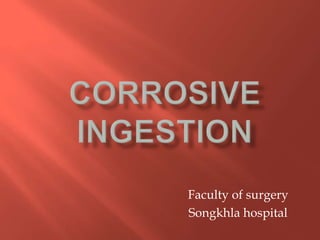
Corrosive ingestion
- 1. Faculty of surgery Songkhla hospital
- 2. 1. Alkalis: Cleaning agents (NaOH), drain openers, bleaches, toilet bowel cleaners, and detergents… 2. Acids Toilet bowel cleaners ( sulfuric, hydrochloric ), anti rust compounds ( hydrochloric, oxalic, hydrofluoric ), swimming pool cleaners ( hydrofluoric )
- 3. Alkalis PH > 7 Tasteless, odorless →larger amounts liquefaction necrosis => direct extension, deeper injuries Esophageal injury is common In stomach, partial neutralization by gastric acid may result limited injury Duodenal injury is less common Acid PH < 7 Pungent odor and noxious taste coagulation necrosis => formation of a coagulum layer : limit the depth of injury Less esophageal injury More gastric injury As the acid toward the pylorus, pylorospasm impairs emptying into the duodenum
- 4. Corrosive properties of the ingested substance Amount, concentration, and physical form (solid or liquid) of the agent Duration of contact with the mucosa
- 5. 1. Vary widely Hoarseness, stridor, dyspnea => Airway evaluation Perforation: (During first 2 weeks) Retro-sternal or back pain Localized abdominal tenderness, rebound, rigidity, Psoas sign, obturator sign Massive hematemesis Dysphagia, odynophagia, drooling, nausea, vomiting 2. Early signs and symptoms may not correlate with the severity and extent of tissue injury 3. Oropharyngeal burns (-) :10-30% esophageal burns(+) Oropharyngeal burns (+) : 70% esophageal burns(-)
- 6. Avoid: The use of emetics: re-exposes Neutralizing agents: thermal injury Gastric lavage: may induce retching and vomiting which can compound injury
- 7. Primary survey Keep NPO IV fluids administer Gastric acid suppression with intravenous PPI Adequate pain relief with intravenous narcotics Airway evaluation - laryngoscopy R/O perforation - Plain films of chest and abdomen Observation for Clinical signs of perforation, mediastinitis, or peritonitis Broad spectrum antibiotics - given for patients with Grade 3 caustic injury or high suspicion for esophageal perforation. Endoscope
- 8. 1. Timing: No later than 24 hours Usually avoided from 5-15 days 2. Purpose: Grading, manage appropriately 3. Risk of perforation: Low, under adequate sedation 4. Extent: Advance until a circumferential second or third degree burn is seen To first part of duodenum
- 9. Grade 0: Normal Grade 1: Mucosal edema and hyperemia Grade 2A: Superficial ulcers, bleeding, exudates => Excellent prognosis Grade 2B: Deep focal or circumferential ulcers Grade 3A: Focal necrosis => Develop strictures: 70-100% Grade 3B: Extensive necrosis => Early mortality rate: 65%
- 12. 1. Patients with mild or no injury ○ may be discharged. 2. Patients with grade 1 or 2A injury ○ require no therapy. ○ a liquid diet may be initiated ○ advanced to a regular diet in 24 to 48 hours. 3. Patients with grade 2B or 3 injuries ○ should have nasoenteric tube feeding initiated after 24 hours. ○ oral liquids are allowed after the first 48 hours if the patient is able to swallow saliva. ○ steroids ???. *Patients with grade 3 injuries should be carefully observed for signs of perforation over at least a one-week. Prophylactic esophageal stenting is not recommended.
- 13. In animal studies: incidence of stricture formation In human studies: Inconclusive so far NEJM. 1990: Prospective study over an 18-year period No benefit Related only to the severity of the corrosive injury Toxicol Rev. 2005: 1991-2004 in the English, German, French, Spanish No benefit
- 14. Clinical signs of perforation, mediastinitis, or peritonitis are indications for emergency surgery. Esophagectomy may be required for patients with severe strictures. Minimally invasive esophagectomy approach may be preferred because it is associated with a decreased hospital stay compared with standard esophagectomy. The most important factors to guarantee a successful outcome for surgery are good vascular supply and absence of tension at the anastomosis. If the stomach is damaged as well as the esophagus, a colonic interposition can be used to create a new conduit.
- 15. The prognosis is variable and depends upon the grade of esophageal injury and the underlying medical condition of the patient. Most deaths are due to the sequelae of perforation and mediastinitis.
- 17. 1. Stricture formation one-third of patients suffered caustic esophageal injury develop esophageal strictures Primarily in those with grade 2B or 3 injury Peak incidence: two months Occur as early as two weeks or as late as years after ingestion Barium swallow examination is useful in the evaluation
- 19. 1. Endoscopic dilatation The goal: dilate the esophageal lumen to 15 mm Perforation rate: 0.5% Special consideration: Long, eccentric strictures: risk of perforation increased Thick-walled strictures: recur rapidly Multiple sessions: elective esophageal resection 2. Intraluminal stent Temporary placement of a self-expanding plastic stent Successful in case reports 3. Surgery Esophagectomy with colonic interposition Gastric transposition: high leak rate Perform 6 months later
- 21. 2. Esophageal carcinoma Incidence: 1000 to 3000-fold increase 3% have history of caustic ingestion Mean latency: 41 years (13-71years) Scar carcinoma: Less distensible => dysphagia presents earlier Lymphatic spread and direct extension Endoscope surveillance Begin 15-20 years after ingestion The time interval : No more than every 1-3 years
- 24. Severity depend upon: the amount, concentration, physical form and the duration of contact with the mucosa. The absence of oropharyngeal burns does not preclude the presence of esophageal or gastric injury. The use of emetics, neutralizing agents, or nasogastric intubation to remove remaining caustic material is contraindicated. Gastrointestinal endoscopy should be performed in first 24 hours. Endoscopy is contraindicated if hemodynamic instability, evidence of perforation, severe respiratory distress, or severe oropharyngeal or glottic edema and necrosis. Clinical signs of perforation, mediastinitis or peritonitis are indications for emergency surgery. Long-term complications include esophageal strictures and esophageal squamous cell carcinoma. Endoscopic surveillance for cancer is recommended at 15-20 years after ingestion.
